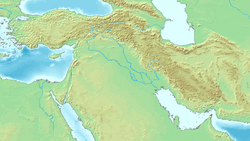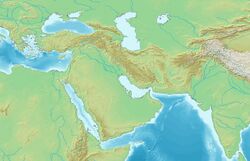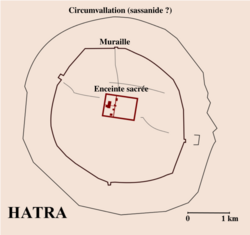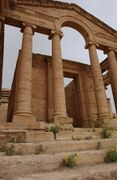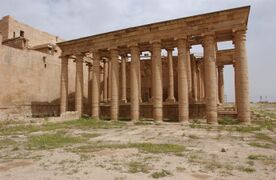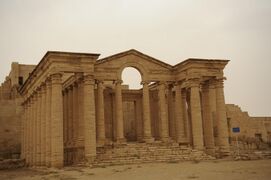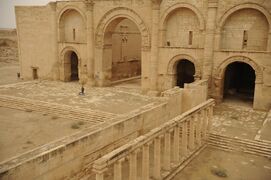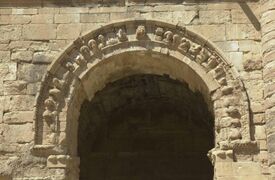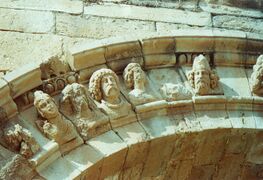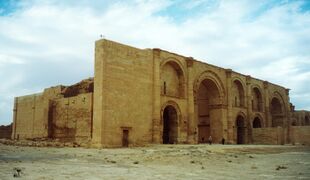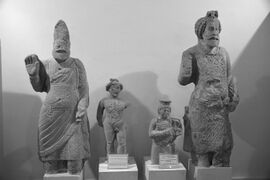Hatra
Topic: Place
 From HandWiki - Reading time: 9 min
From HandWiki - Reading time: 9 min
الحضر | |
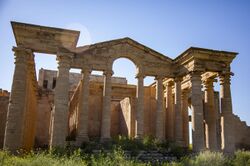 The ruins of Hatra in 2019 | |
| Alternative name | al-Ḥaḍr |
|---|---|
| Location | Hatra District, Nineveh Governorate, Iraq |
| Region | Mesopotamia |
| Coordinates | [ ⚑ ] : 35°35′17″N 42°43′6″E / 35.58806°N 42.71833°E |
| Type | Settlement, temple |
| Area | 300 ha (740 acres) |
| History | |
| Founded | 3rd or 2nd century BC |
| Abandoned | 241 AD |
| Cultures | Arab,[citation needed] Mesopotamian, Assyrian, Parthian |
| Satellite of | Parthian Empire |
| Site notes | |
| Condition | Ruins |
| Public access | Accessible |
| Official name | Hatra |
| Type | Cultural |
| Criteria | ii, iii, iv, vi |
| Designated | 1985 (9th session) |
| Reference no. | 277 |
| Region | Arab States |
Hatra (/ˈhæ.trə/; Arabic: الحضر; Syriac: ܚܛܪܐ) was an ancient city in Upper Mesopotamia located in present-day eastern Nineveh Governorate in northern Iraq. The city lies 290 km (180 mi) northwest of Baghdad and 110 km (68 mi) southwest of Mosul. It is considered the richest archaeological site from the Parthian Empire known to date.[1]
Hatra was a strongly fortified caravan city and capital of the small Arab Kingdom of Hatra, located between the Roman and Parthian/Sasanian Empires. Hatra flourished in the 2nd century, and was destroyed and deserted in the 3rd century. Its impressive ruins were discovered in the 19th century.[2]
Name
Hatra is known as al-Ḥaḍr (الحضر) in Arabic. It is recorded as 𐣧𐣨𐣣𐣠 (ḥṭrʾ, vocalized as: Ḥaṭrāʾ) in Hatran Aramaic inscriptions, probably meaning "enclosure, hedge, fence". In Syriac, it is usually recorded in the plural form Ḥaṭrē. In Roman works, it is recorded as Greek Átra and Latin Hatra and Hatris.[2]
The city was officially called Beit ʾElāhāʾ 𐣡𐣩𐣵 𐣠𐣫𐣤𐣠 "House of God", in Hatran Aramaic inscriptions[3] and once recorded as "Enclosure of Shamash" (ḥtrʾ d-šmš 𐣧𐣨𐣣𐣠 𐣣𐣴𐣬𐣴 ) on a coin.[2]
History
There is no archeological information on the city before the Parthian period but settlement in the area likely dates back to at least the Seleucid period.[2] Hatra flourished under the Parthians, during the 1st and 2nd centuries AD, as a religious and trading center.[4] Later on, the city became the capital of possibly the first Arab Kingdom in the chain of Arab cities running from Hatra, in the northeast, via Palmyra, Baalbek and Petra, in the southwest. The region controlled from Hatra was the Kingdom of Hatra, a semi-autonomous buffer kingdom on the western limits of the Parthian Empire, governed by Arabian princes.
Hatra became an important fortified frontier city and played an important role in the Second Parthian War, withstanding repeated attacks by the Roman Empire. During the 2nd century CE the city repulsed sieges by both Trajan (116/117) and Septimius Severus (198/199).[5] Hatra's forces defeated the ascendant Sassanid Persians in 238 at the battle of Shahrazoor, but fell shortly after in 241 to the army of Sassanid king Shapur I and was destroyed.[5] The traditional stories of the fall of Hatra tell of al-Nadirah, daughter of the King of Araba, who betrayed the city into the hands of Shapur as she fell in love with him. The story tells of how Shapur killed the king and married al-Nadirah, but later had her killed also after realizing her ingratitude towards her father.[4][6]
Hatra was the best preserved and most informative example of a Parthian city. Its plan was circular,[7] and was encircled by inner and outer walls nearly 2 kilometres (1.2 mi) in diameter[8] and supported by more than 160 towers. A temenos (τέμενος) surrounded the principal sacred buildings in the city's centre. The temples covered some 1.2 hectares and were dominated by the Great Temple, an enormous structure with vaults and columns that once rose to 30 metres. The city was famed for its fusion of Greek, Mesopotamian, Canaanite, Aramean and Arabian pantheons, known in Aramaic as Beiṯ Ĕlāhā ("House of God"). The city had temples to Nergal (Assyrian-Babylonian and Akkadian), Hermes (Greek), Atargatis (Syro-Aramaean), Allat, Shamiyyah (Arabian), and Shamash (the Mesopotamian sun god).[4] Other deities mentioned in the Hatran Aramaic inscriptions were the Aramaean Ba'al Shamayn, and the female deity known as Ashurbel, which was perhaps the assimilation of the two deities the Assyrian god Ashur and the Babylonian Bel—despite their being individually masculine.
List of rulers
In inscriptions found at Hatra, several rulers are mentioned. Other rulers are sporadically mentioned by classical authors. The earlier rulers are titled mrjʾ (māryā, "lord") and the later ones mlkʾ d-ʿrb ("king of the Arabs"; malkā, "king").[2]
| Name | Title | Date | Portrait | Note | |
|---|---|---|---|---|---|
| 1 | Worod | mry´ | |||
| 2 | Ma’nu | mry´ | |||
| 3 | Elkud | mry´ | 155/156 | ||
| 4 | Nashrihab | mry´ | 128/29 – 137/38 AD | ||
| 5 | Naṣru | mry´ | 128/29 – 176/77 | ||
| 6 | Wolgash I | mry´ and mlk | The two brothers may have been co-rulers. | ||
| 7 | Sanatruq I | mry´ and mlk | 176/177 | ||
| 8 | Abdsamiya | mlk | 192/93 – 201/202 | Supported the Roman emperor Pescennius Niger | |
| 9 | Sanatruq II | mlk – King | 207/08 – 229/230 | Became a vassal of the Romans under Gordian III during Roman–Persian Wars | |
Art of Hatra
According to John M. Rosenfield, the statuary of Hatra belong to the Parthian cultural sphere, with numerous similarities in terms of clothing, decorative elements or posture, which tend to be massive and frontal, with feet often splayed.[9] The architecture of Hatra itself is generally seen as an example of Parthian architecture.[9] Similarities can be seen with the Art of the Kushans as well, due either to direct cultural exchanges between the area of Mesopotamia and the Kushan Empire at that time, or from a common Parthian artistic background leading to similar types of representation.[9]
Military commander from the city of Hatra. Iraq Museum, Baghdad.
Relief of the god Nergal from Hatra.
Modern Hatra
File:Archaelogical site of Hatra (before destruction).webm Hatra was used as the setting for the opening scene in the 1973 film The Exorcist,[10] and since 1985 has been a UNESCO World Heritage Site.[11]
The site was first surveyed by Walter Andrae of the German excavation team working in Assur from 1906 to 1911. But systematic excavations have been undertaken only from 1951 by Iraqi archeologists. From the 1980s, the Italian Archaeological Expedition,[12] directed by R. Ricciardi Venco (University of Turin), made major discoveries at Hatra. The excavations were focused on an important house ("Building A"[13]), located close to the Temenos, and on deep soundings in the Temenos central area.[14] Now the Expedition is active in different projects regarding the preservation and development of the archaeological site.[15] In 1990, a Polish expedition of the Polish Centre of Mediterranean Archaeology University of Warsaw recorded and studied the city's defense walls.[16]
In 2004, The Daily Telegraph stated "Hatra's finely preserved columns and statues make it one of the most impressive of Iraq's archaeological sites"[17]
Restoration by Saddam Hussein
Saddam Hussein saw the site's Mesopotamian history as reflecting glory on himself, and sought to restore the site, and others in Ninevah, Nimrud, Ashur and Babylon, as a symbol of Arab achievement,[18] spending more than US$80 million in the first phase of restoration of Babylon. Saddam Hussein demanded that new bricks in the restoration use his name (in imitation of Nebuchadnezzar) and parts of one restored Hatra temple have Saddam's name.[19]
Destruction by ISIL
Actions by the Islamic State of Iraq and the Levant, which occupied the area in mid-2014, were a major threat to Hatra. In early 2015 they announced their intention to destroy many artifacts, claiming that such "graven images" were un-Islamic, encouraged shirk (or polytheism), and could not be permitted to exist, despite the preservation of the site for 1,400 years by various Islamic regimes. ISIL militants pledged to destroy the remaining artifacts. Shortly thereafter, they released a video showing the destruction of some artifacts from Hatra.[20][21] After the bulldozing of Nimrud on March 5, 2015, "Hatra of course will be next" said Abdulamir Hamdani, an Iraqi archaeologist from Stony Brook University.[22] On March 7, Kurdish and Iraqi official sources reported ISIS had begun the demolishing the ruins of Hatra.[23][24] A video released by ISIL during the next month showed the destruction of the monuments.[25]
UNESCO and ISESCO issued a joint statement saying "With this latest act of barbarism against Hatra, (the IS group) shows the contempt in which it holds the history and heritage of Arab people."[26]
The pro-Iraqi government Popular Mobilization Forces captured the city on 26 April 2017.[27] A spokeswoman for the militias stated that ISIL had destroyed the sculptures and engraved images of the site, but its walls and towers were still standing though contained holes and scratches received from ISIL bullets. PMF units also stated that the group had mined the site's eastern gates, thus temporarily preventing any assessment of damage by archaeologists.[28] It was reported on 1 May that the site had suffered less damage than feared earlier. A journalist of EFE had earlier reported finding many destroyed statues, burnt buildings as well as signs of looting. Layla Salih, head of antiquities for Nineveh Governorate, stated that most of the buildings were intact and the destruction didn't compare with that of other archaeological sites of Iraq. A PMF commander also stated that the damage was relatively minor.[29]
Gallery
Climate
Hatra has a hot semi-arid climate (Köppen climate classification BSh). Most rain falls in the winter. The average annual temperature in Hatra is 20.7 °C (69.3 °F). About 257 mm (10.12 in) of precipitation falls annually.
Script error: No such module "weather box".
See also
- Aramaic of Hatra
- Destruction of cultural heritage by ISIL
- Taq-i Kisra, sharing architectural features with structures at Hatra
References
- ↑ Dirven, L. (2013). Hatra: Politics, Culture and Religion Between Parthia and Rome. Franz Steiner Verlag. ISBN 978-3-515-10507-1. https://books.google.com/books?id=U35zzwEACAAJ. Retrieved 2023-09-29.
- ↑ 2.0 2.1 2.2 2.3 2.4 Schmitt, Rüdiger. "HATRA". Encyclopaedia Iranica. http://www.iranicaonline.org/articles/hatra.
- ↑ "Hatra | ancient city, Iraq" (in en). https://www.britannica.com/place/Hatra.
- ↑ 4.0 4.1 4.2 "Hatra". Encyclopædia Britannica. http://www.britannica.com/eb/article-9039509/Hatra. Retrieved 14 December 2013.
- ↑ 5.0 5.1 Advisory Body Evaluation on Hatra. International Council on Monuments and Sites (ICOMOS). 1985. pages 1–2.
- ↑ (in en) E.J. Brill's First Encyclopaedia of Islam 1913–1936. BRILL. 1987. p. 207a. ISBN 9789004082656.
- ↑ Salma, K. Jayyusi; Holod, Renata; Petruccioli, Attilio; André, Raymond (2008). The City in the Islamic World. Leiden: Brill. p. 174. ISBN 9789004162402. https://archive.org/details/cityislamicworld00jayy.
- ↑ "Hatra UNESCO World Heritage Centre". UNESCO. 1992–2015. https://whc.unesco.org/en/list/277.
- ↑ 9.0 9.1 9.2 Rosenfield, John M. (1967) (in en). The Dynastic Arts of the Kushans. University of California Press. pp. 170–173. https://books.google.com/books?id=udnBkQhzHH4C&pg=PA170.
- ↑ Freeman, Colin s (25 June 2014). "Iraq's 'Exorcist' temple falls into Isis jihadist hand". The Telegraph (London). https://www.telegraph.co.uk/news/worldnews/middleeast/iraq/10925751/Iraqs-Exorcist-temple-falls-into-Isis-jihadist-hands.html.
- ↑ "Hatra". UNESCO. https://whc.unesco.org/en/list/277.
- ↑ Hatra – Italian Archaeological Expedition
- ↑ "L'Edificio A" (in it-IT). 2016-11-25. https://hatrasite.com/ledificio-a/.
- ↑ "I sondaggi del Temenos" (in it-IT). 2016-11-25. https://hatrasite.com/i-sondaggi-del-temenos/.
- ↑ "Progetti/ Projects" (in it-IT). 2016-12-10. https://hatrasite.com/progetti-projects/.
- ↑ Gawlikowski, Michał (1991). "The first season of excavations in Hatra, Iraq.". Polish Archaeology in the Mediterranean. 2. https://www.pcma.uw.edu.pl/wp-content/uploads/pam/PAM_1990_II/473.pdf.
- ↑ Freeman, Colin (4 January 2004). "American troops launch 'Exorcist' tour at ancient temple". The Telegraph. https://www.telegraph.co.uk/news/worldnews/middleeast/iraq/1450907/American-troops-launch-Exorcist-tour-at-ancient-temple.html.
- ↑ Lawrence Rothfield (1 Aug 2009). The Rape of Mesopotamia: Behind the Looting of the Iraq Museum. University of Chicago Press. ISBN 9780226729435. https://archive.org/details/rapeofmesopotami00roth.
- ↑ "Ancient Hatra Ruins". Defense Video & Imagery Distribution System. 9 September 2006. https://www.dvidshub.net/video/17073/ancient-hatra-ruins.
- ↑ Cockburn, Patrick (27 February 2015). "Iraq: Isis militants pledged to destroy remaining archaeological treasures in Nimrud". The Independent. https://www.independent.co.uk/news/world/middle-east/iraq-isis-militants-pledge-to-destroy-remaining-archaeological-treasures-in-nimrud-10076133.html.
- ↑ "ISIL video shows destruction of 7th century artifacts". aljazeera.com. 26 February 2015. http://america.aljazeera.com/articles/2015/2/26/isil-seen-in-new-video-destroying-7th-century-artifacts.html.
- ↑ Karim Abou Merhi (5 March 2015). "IS 'bulldozed' ancient Assyrian city of Nimrud, Iraq says". https://news.yahoo.com/bulldozed-ancient-assyrian-city-nimrud-iraq-govt-203312292.html.
- ↑ Yacoub, Sameer N. (7 March 2015). "IS destroying another ancient archaeological site in Iraq". Army Times. Associated Press (United States). http://www.armytimes.com/story/military/2015/03/07/is-destroying-another-ancient-archaeological-site-in-iraq/24556625/.
- ↑ "Islamic state 'demolish' ancient Hatra site in Iraq". BBC. 29 September 2022. https://www.bbc.co.uk/news/world-middle-east-31779484.
- ↑ Vivian Salama (4 Apr 2015). "Video: Islamic State group shot, hammered away Iraq's Hatra". Associated Press. https://apnews.com/article/bcdd18ddfe5143f08e5e2335e19e5af9.
- ↑ Yacoub, Sameer N.; Salam, Vivian (7 March 2015). "IS destroying another ancient site in Iraq". The Telegraph. Macon, Georgia. http://www.macon.com/2015/03/07/3624731/is-destroying-another-ancient.html.
- ↑ "Iraqi forces retake damaged Hatra heritage site from IS". Deutsche Welle. 26 April 2017. http://www.dw.com/en/iraqi-forces-retake-damaged-hatra-heritage-site-from-is/a-38601736.
- ↑ Hussain, Rikar (27 April 2017). "Iraqi Militias Find Relics Destroyed by IS in Ancient Town". Voice of America. https://www.voanews.com/a/iraqi-militias-find-relics-destroyed-ancient-town/3828751.html.
- ↑ "Hatra: IS damage to ancient Iraqi city less than feared". BBC News. 1 May 2017. https://www.bbc.co.uk/news/world-middle-east-39770395.
Further reading
- al-Salihi, W. (2021). "Hatra: Three Notes, Historical, Iconographical, and Religious". Iraq 83: 3–12. doi:10.1017/irq.2021.12.
External links
- Between Rome and Parthia: The Desert City of Hatra
- http://lexicorient.com/e.o/hathra.htm
- http://www.britannica.com/eb/article-9039509
- http://shezaf.net/english/Video/Video/Hatra.html
- http://www.bbc.co.uk/archive/chronicle/8612.shtml BBC Chronicle "Lost Kings of the Desert"
- https://hatrasite.com/ Italian Archaeological Expedition at Hatra
- Iraqi forces seize ancient UNESCO site of Hatra from Islamic State as jihadis execute Mosul civilians
 |
 KSF
KSF
